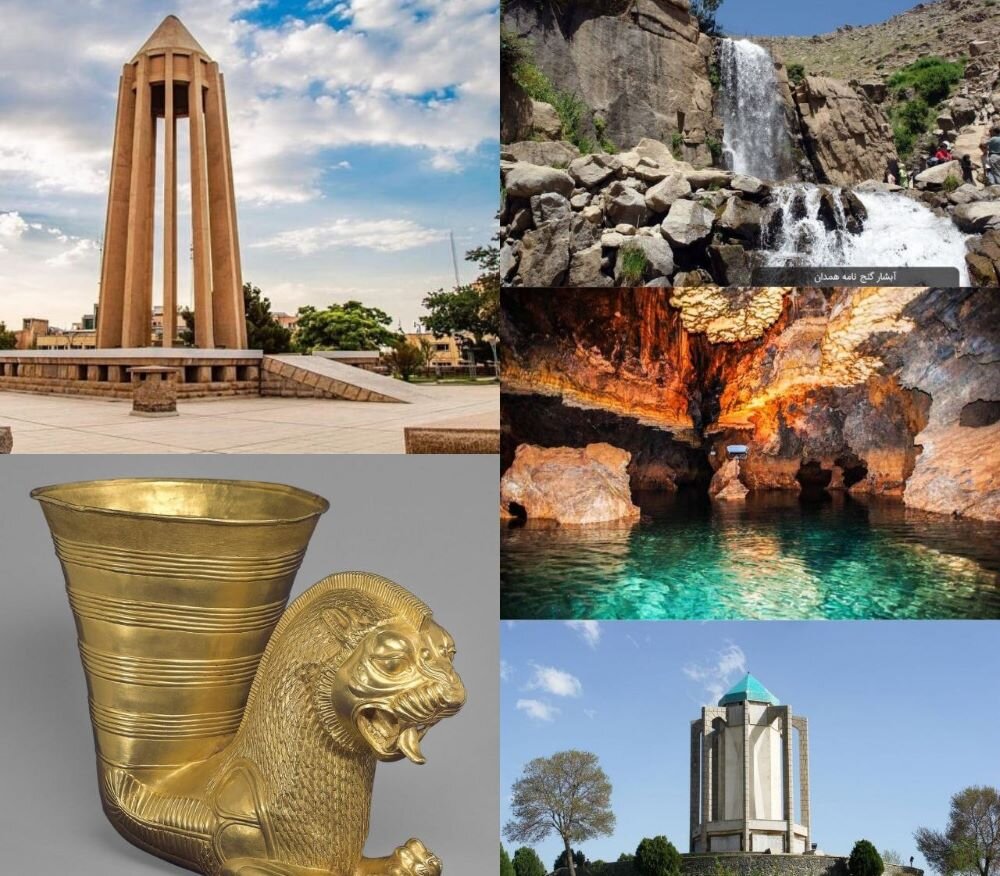Hamadan is one of Iran’s oldest cities and the first capital of Medes, Iran’s first empire. Hamadan is home to many poets and cultural celebrities. Apart from this, the city’s dozens of sights and historic locations stand up to us in Iran and one of the world’s most historic cities.
Hamadan has special and famous tourist attractions and attractions suitable for a fun spring trip.

Due to the geographical conditions of Hamadan, the city has an untouched and unique nature.

The state is also well known for its handicrafts such as leather, ceramics and carpets.
hegmataneh (ekbatana)
A site you should not miss during your stay in Hamadan is the excavation of Hegmatane (Ekbatana) and its museum.

This ancient city was the first capital of the Aryans and, along with Athens in Greece, Rome in Italy, and Susa in Fuzestan, one of the few ancient cities in the world, still survived and is important.

The median kingdom was founded in the 8th century BC by Deioces or Dia-Oku, and Hegmataneh was built as the capital.
Hegmataneh is the largest archaeological site in Iran, and at the end of the 20th century it is a bare treasure, allowing you to discover ancient and almost completely geometric cities.

You can admire the house built back on its back, resembling a street perpendicular to each other.
The museum dedicated to excavations displays many Achemenid, Sassanian and median objects, and actually plunges into the past until the time when Ekbatana was still the central capital of the kingdom and one of the most influential cities in the world.

Inscription of ganjnameh
The geographically located inscription of Ganjuname, located southwest of Hamedan, is a historic monument dating back to the Achemenid period.
They were engraved on Albando Mountain, on the edge of the Abbas Abbado Valley. These inscriptions are in three columns of 20 rows and are written in three languages: old Persian, neoramite and neobabylonian.
By looking at the inscription you will definitely feel the wonders of history.

Next to the inscription of Ganjnamhe is a waterfall filled with water every season. This really adds to the beauty of the environment.
The largest water cave in the world
One of the biggest attractions in Hamadan province and the world’s largest water cave, Alisadr is ranked among Iran’s most popular locations, with thousands of visitors throughout the year, especially in spring and summer.
The cave is located in Kabud Ahan, a city 60 km from Hamadan. The distance from Kabudalahan to Alisador village is 50 km. This cave is located in the highlands of Salicie, meaning yellow rock.

Alisadr Cave has too many water holes and has a variety of beautiful features, such as stal litter, male dogs, and Carst sediments.
It is the largest cave in the world in this respect, with a presence of about 2400 meters in cave boat. This cave has a permanent system of exploitation and protection management.
Baba Taher’s grave
Baba Taha Oliyan’s tomb is a commemorative building of the modern era. It is located on the raised ground northwest of Hamedan city in Babatahar Square.

Baba Taha lived in the 11th century. He was one of the great poets and mystics of his time.
Avicenna Mausoleum
The Avicenna Mausoleum is a monument to famous Iranian philosophers, scientists and doctors. This monument is located in the Abu Alisina (Persian Abiken) Square in Hamedan.

It is a convenient location in this historic square and attracts many people who pass through the city of Hadan to visit this spirit us, making it easy to access.
Avisenna’s fame in medicine and philosophy made him a world-renowned figure. Therefore, the number of tourists travelling to visit the spirit of this great philosopher is important.
Shir Sangi, center of Stone Lion
The Stone Lion of Hamedan (Siah Sangi) is a historic monument in Hadan, west of Iran. The Stone Lion, part of the “Gate of the Lion,” is on a hill where a Parthian cemetery is said to have been placed.

When it was first built, the statue had twin counterparts, both of which constituted the old gates of the city. The gate was demolished as Deiram took over the city at 931ce. Today, the statue is located in the park and in the square of Sang Shir, and is held in great respect by the people.
At 2.5 meters long, 1.15 meters wide and 2.2 meters high in the front, the current form represents a battered image of a legless sophanthrion carved from yellow sandstone.

There are many different theories regarding the history of this statue. Some accounts show statues of the first Iranian dynasty, but Medes is attributed to the Parthian dynasty as it was discovered on a mound consisting of Parthian cemeteries.
Iranian cultural heritage groups report that the Lions were first thought to have been built by the orders of Alexander the Great to commemorate the death of his close companion, Heffers.
Larezin; the world’s ceramic capital
Larezin, a city located northwest of Iran’s Hamadan province, is known as the world’s capital pottery.
The small town of Larezin celebrated its designation as the capital of world ceramics by the World Craft Council in 2016.

Approximately 80% of Larezin’s population are potters and potters, and are involved in related jobs. Without a doubt, Larezin is one of the key centres of Iran’s pottery and ceramic production.

